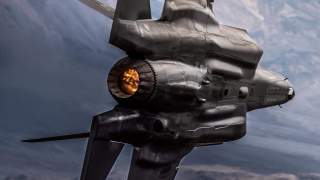The F-35 Can Go Into Beast Mode (Think More Missiles But Less Stealth)
A good idea?
Key point: An improved stand-off capability.
The U.S. military could hang more weapons under the wings of its F-35 stealth fighters.
Lockheed Martin, which assembles the single-engine, radar-evading jets, in early May 2019 revealed a concept for a hypersonic surface-to-air missile that’s compatible with the U.S. Navy’s F-35C.
Lockheed for years has been working with the U.S. Air Force and the Defense Advanced Research Projects Agency to develop the Hypersonic Air-breathing Weapon Concept hypersonic missile. “HAWC, which has so far been under development as a land-attack weapon, is set to fly for the first time before the end of the year,” Joe Trevithick reported at The War Zone.
The artist's conception of an F-35C firing a HAWC derivative first appeared at the Navy League's annual Sea, Air, Space convention just outside of Washington, D.C., on May 6, 2019. The rendering shows the stealth aircraft configured to carry two of these weapons externally, one under each wing. ....
As its name suggests, HAWC is an air-breathing weapon that flies at hypersonic speed, which is typically defined as anything above Mach five. The Air Force and DARPA have said that missile will use a rocket booster to accelerate to at least that speed, after which a high-speed scramjet engine will kick in and ensure it maintains a speed between Mach five and 10.
HAWC apparently is too big to fit in the F-35’s internal weapons bay. To minimize the F-35’s radar signature, Lockheed designed the plane to carry weapons internally. But the fighter’s dense internal layout doesn’t leave a lot of space for munitions.
The Air Force’s F-35A and the Navy’s F-35C internally can carry no more than four AIM-120 air-to-air missiles, although Lockheed is developing a special rack that could boost this number to six.
The U.S. Marine Corps’ vertical-landing F-35B, which features a downward-blasting lift engine that the other variants lack, has a smaller weapons bay and internally can carry only two AIM-120s and also is too small for the special rack.
But all the F-35 variants also come with underwing hardpoints. Crews can hang tons of missiles and bombs from the wings, albeit at the cost of the F-35’s radar stealth. The U.S. military even has a nickname for this configuration: “beast mode.”
The F-35As the Air Force in May 2019 deployed to the Middle East for operations targeting Islamic State in Iraq and Syria frequently fly in beast mode. Islamic State forces lack significant air defenses.
The Air Force released photos of the F-35s in the Middle East externally carrying six GBU-49 laser-guided bombs and two AIM-9X infrared-guided air-to-air missiles.
HAWC for one clearly is a beast-mode-only weapon, “which would effectively eliminate [the F-35’s] stealth qualities,” Trevithick wrote. “However, the speed and range of hypersonic weapons give them an intrinsic stand-off capability, making this a less pressing issue.”
HAWC could arm other warplane types, of course, Trevithick pointed out.
HAWC, or a maritime strike variant thereof, could just as easily be an option for other Navy fighter jets, such as the F/A-18E/F Super Hornet, underscoring the reality that fighters will increasingly be carrying outsized stand-off weapons as time goes on.
Larger platforms, such as the Navy's P-8A Poseidon maritime patrol aircraft, might find themselves carrying HAWC follow-on variants, too. An anti-ship variant could also find a home in the Air Force on that service's B-1 or B-52 bombers, the former of which are already able to carry Lockheed Martin's AGM-158C Long Range Anti-Ship Missile, giving them a significant new maritime strike role. …
But, at the moment, any actual follow-on variants of HAWC still seem to be a ways off. At present, HAWC is in a "race" with another U.S. military hypersonic weapon program, Tactical Boost Glide, to see which will fly first. DARPA is developing TBG, which is an unpowered boost-glide vehicle, together with the Air Force and the U.S. Navy for air- and ship-launched applications, respectively.
David Axe serves as Defense Editor of the National Interest. He is the author of the graphic novels War Fix,War Is Boring and Machete Squad.

